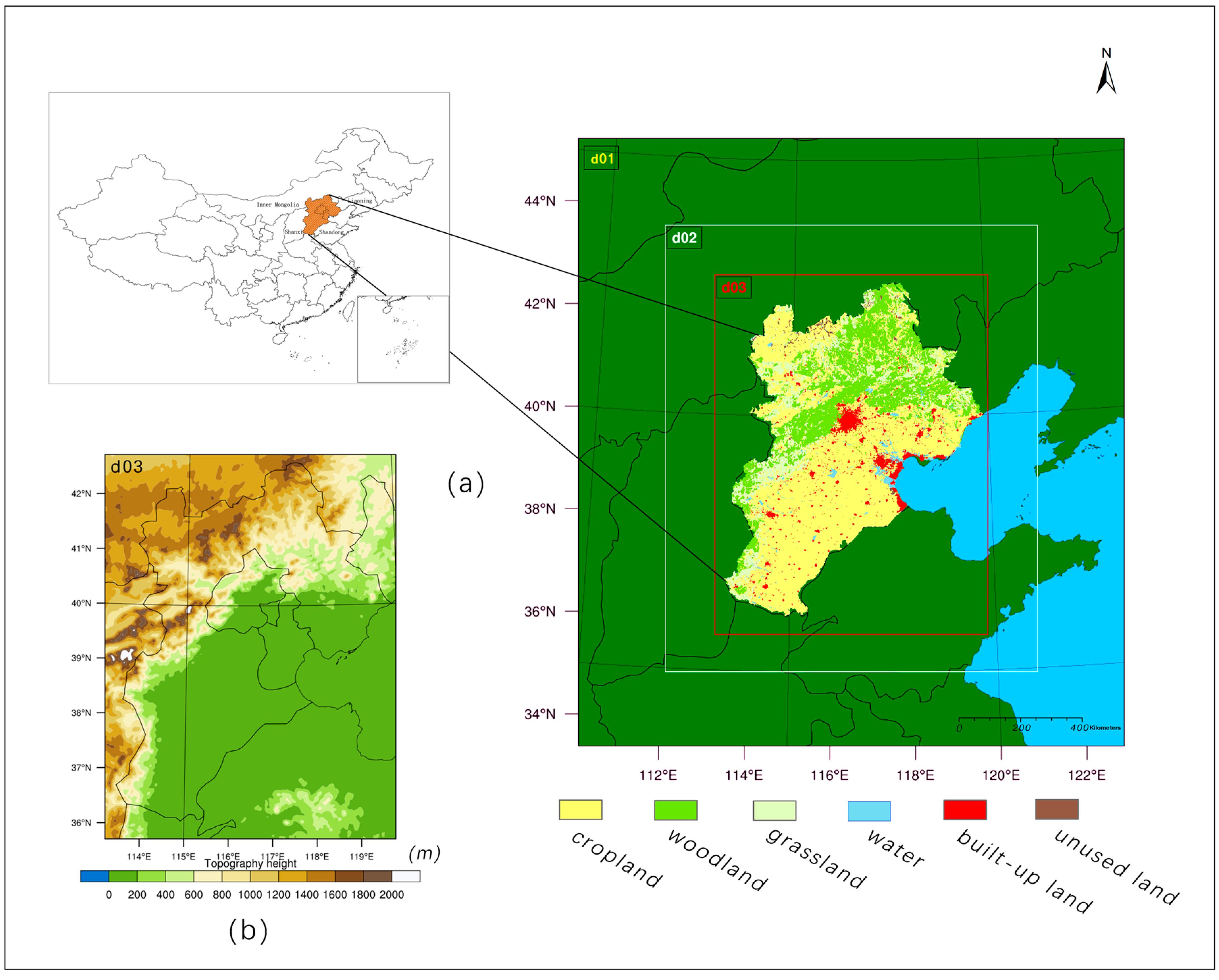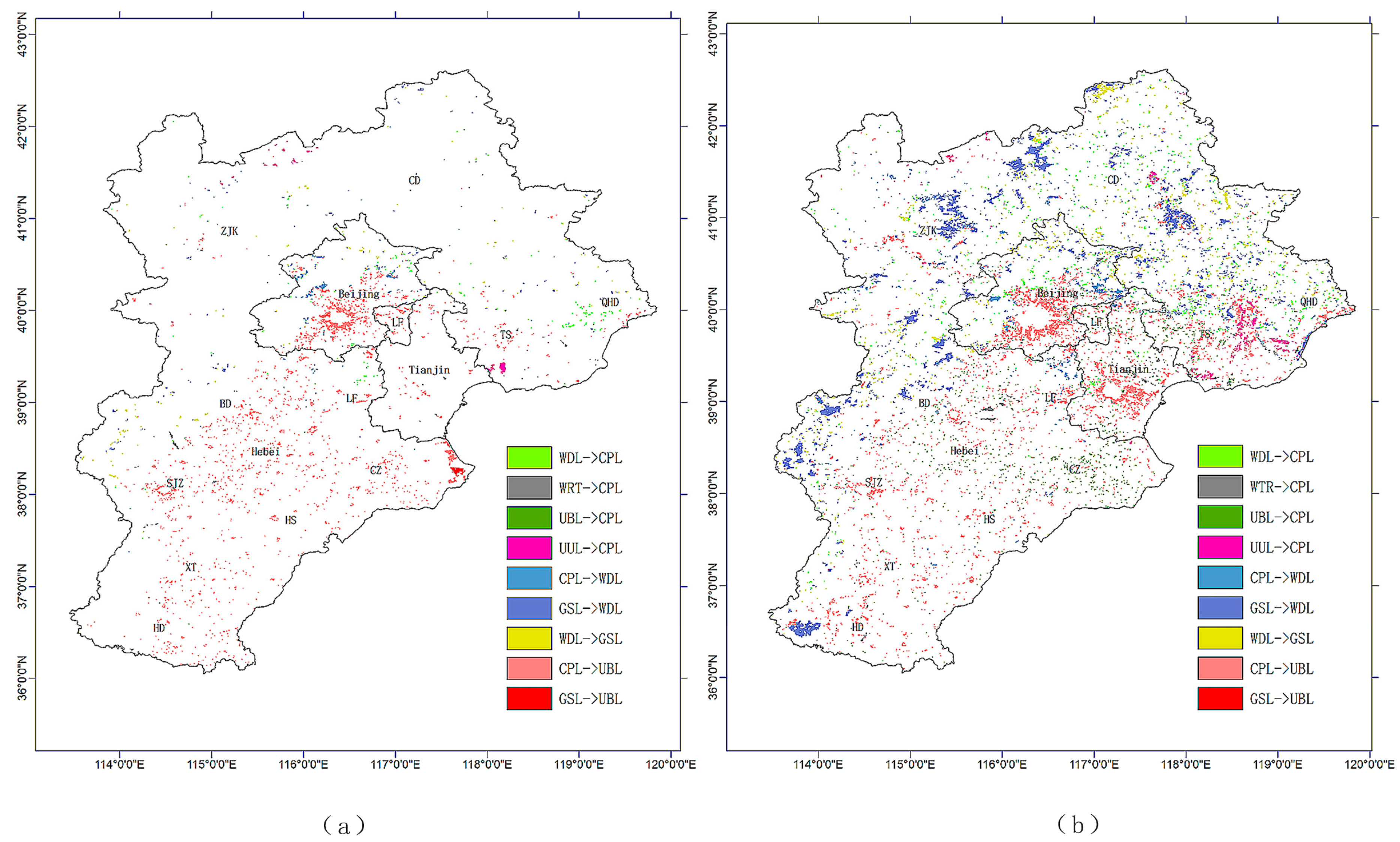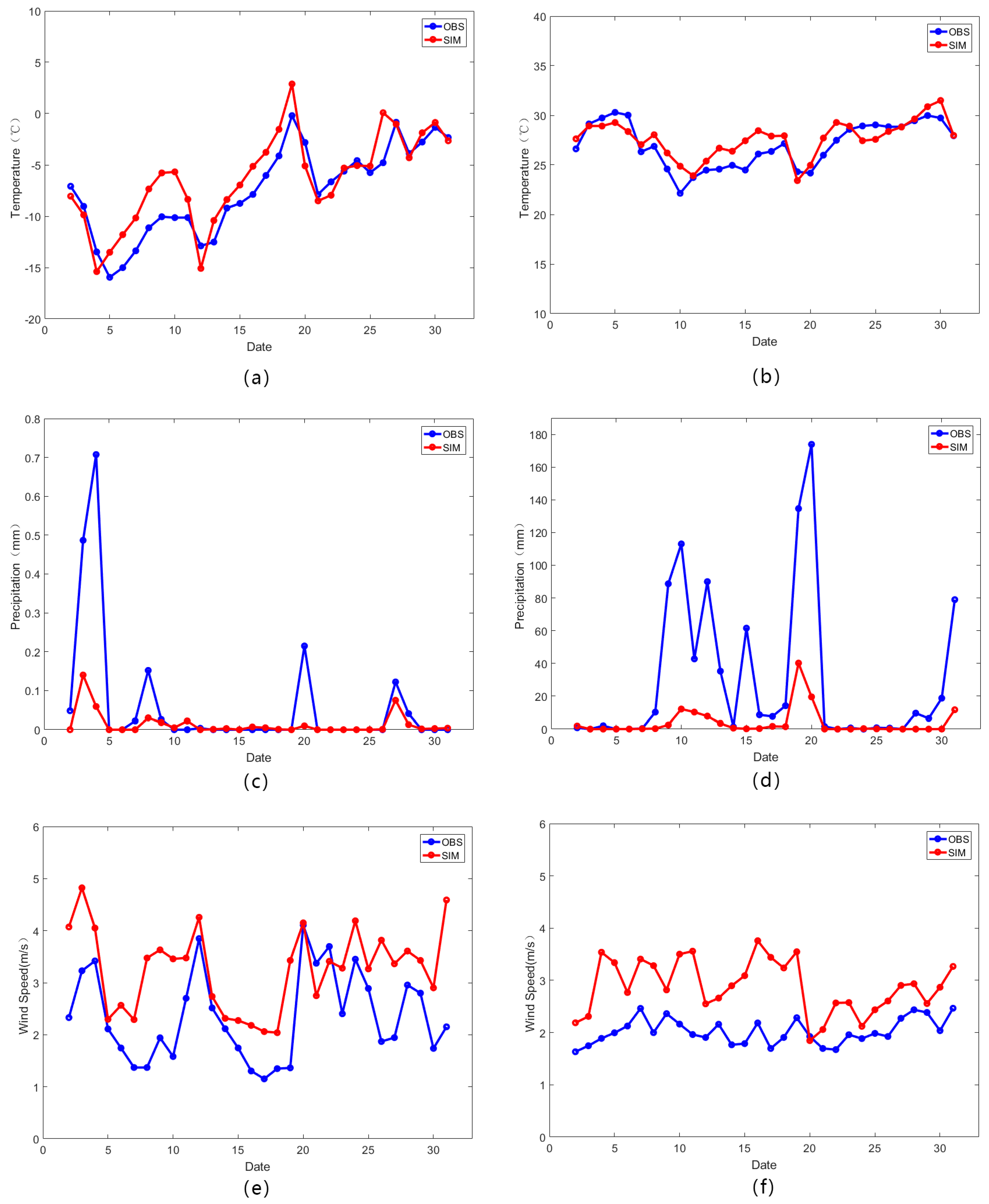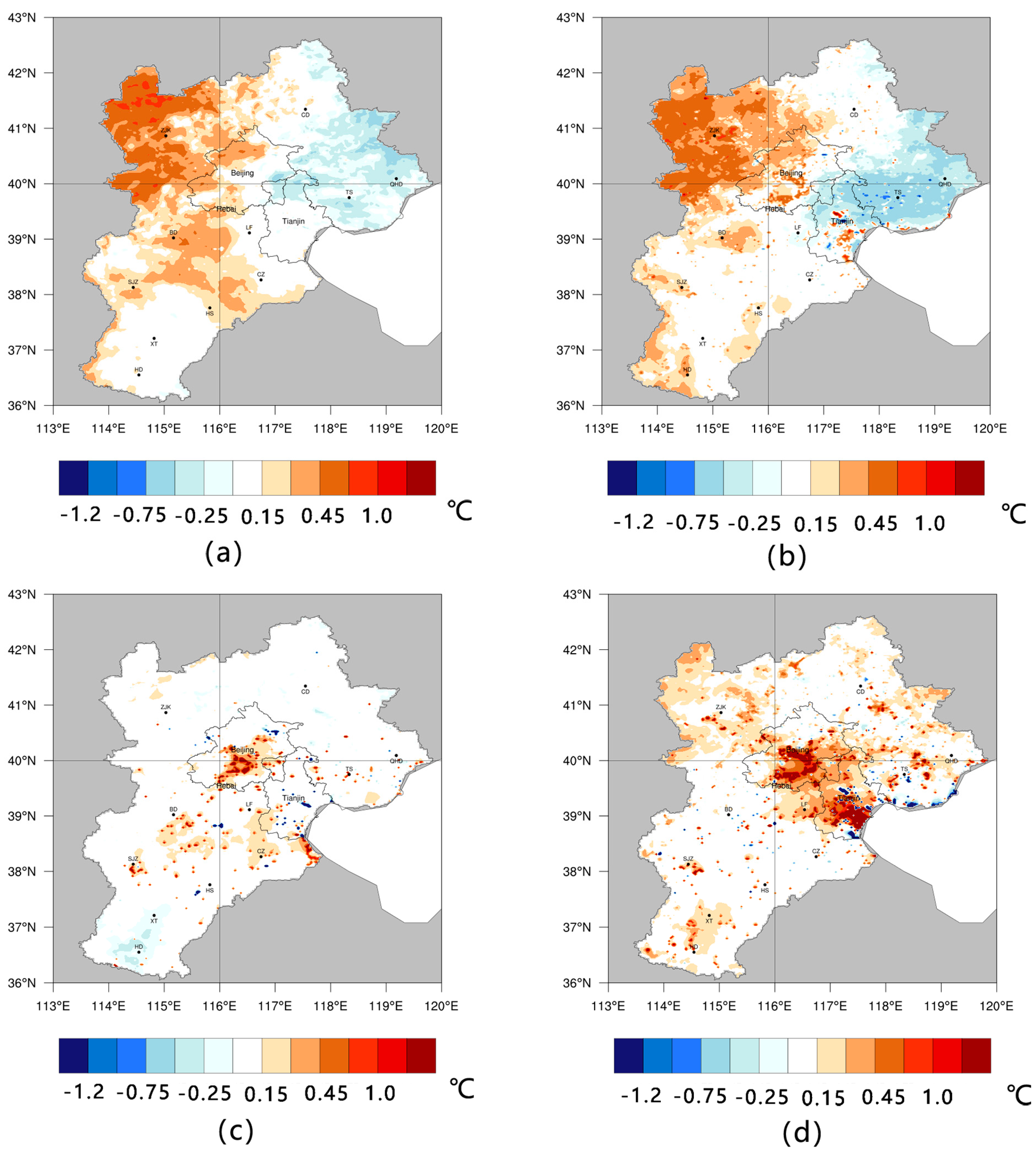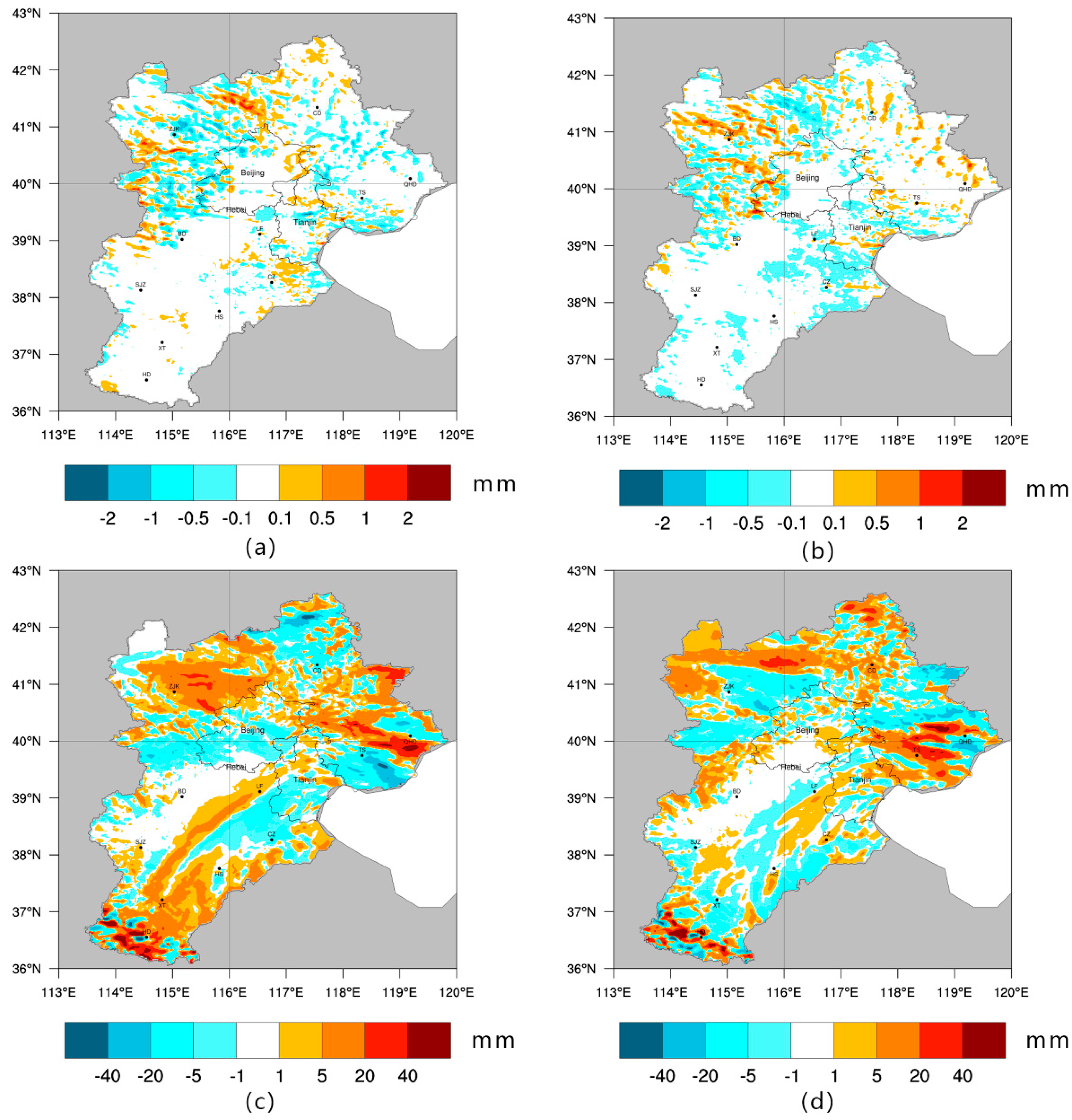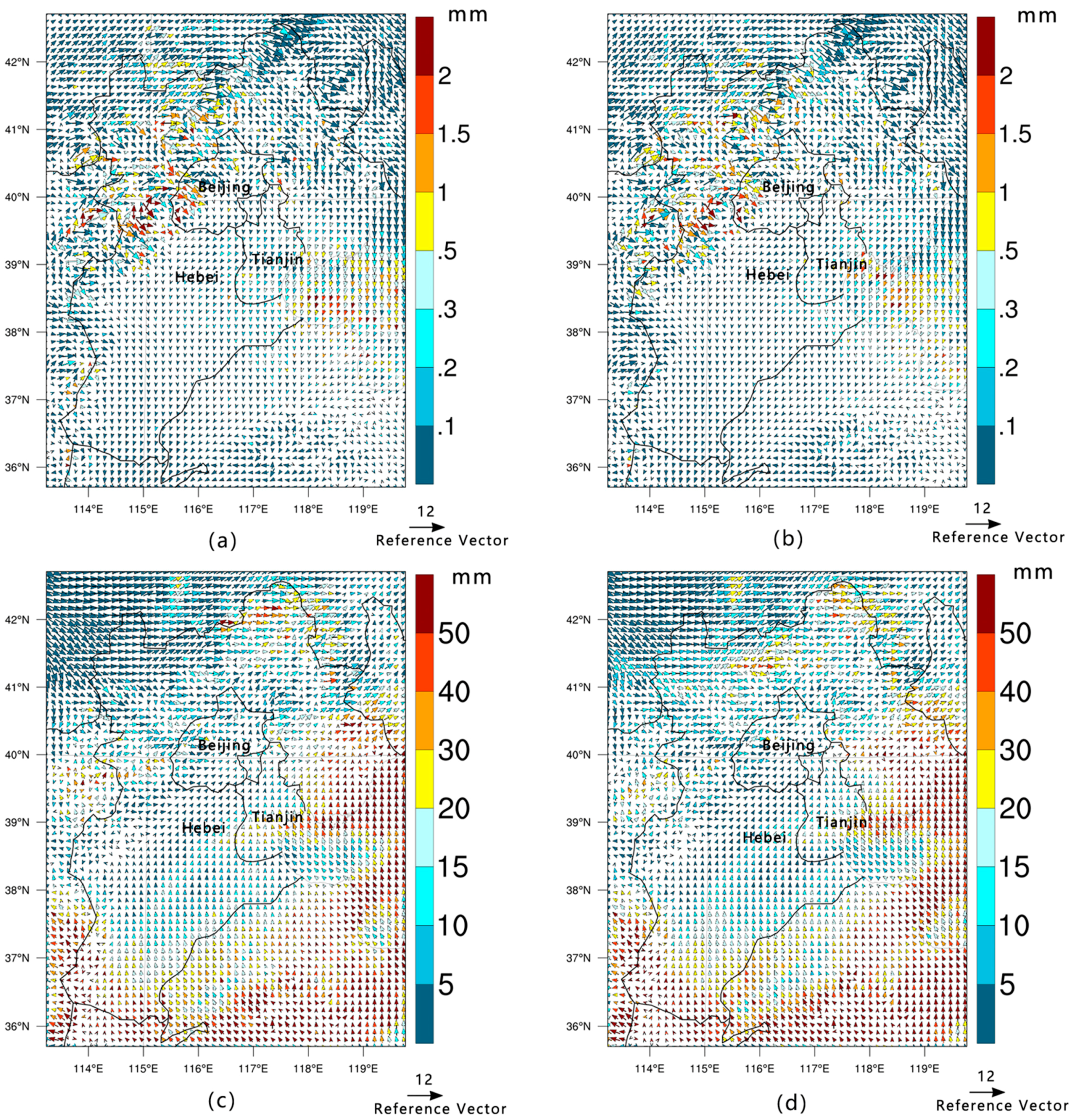1. Introduction
Land use and land cover (LULC) not only reflects human activity, it but also impacts climate [
1,
2,
3,
4]. LULC alters a significant part of Earth’s surface. It is estimated that over 45% of the Earth’s surface is affected by artificial changes in LULC from its natural state [
5]. With the major change in climate, many researchers have extensively explored this issue. The fifth report of the Intergovernmental Panel on Climate Change (IPCC) also notes that since the industrial revolution, urban expansion has become one of the main causes of global warming, while sea level rise and frequent extreme weather events have a certain relationship with forest and grassland degradation [
6], which influenced people’s lives [
7]. In recent decades, LULC has undergone substantial changes in China during its shift from an agricultural to an industrialized country, which was accompanied by the process of urbanization [
8,
9]. This is especially true in the Beijing–Tianjin–Hebei (BTH) region, which is one of the largest city agglomerations in China. The BTH has already attracted considerable focus regarding this issue [
10,
11], and the establishment of a new area of development (i.e., the Xiong’an New Area) in April 2017 makes studies regarding the impact of LULC on climate in this area significant.
There are many studies on the change in LULC in this region and its impact on climate change. However, given rapid urbanization in the BTH region, scholars have focused their research on specific cities [
12,
13,
14]. There are many articles on the study of the urban heat island (UHI) effect caused by the transition from natural land to urban land; for example, Wang and Yan [
15] noted that one impact from the urbanization of cropland is a rise of 1–2 °C in annual surface temperature. Wind speed and the water vapor mixing ratio (annual averages) have both declined in the north BTH region. Moving beyond the UHI, Wang and Feng [
16] simulated precipitation in one non-urbanized and two urbanized scenarios in the BTH region and found that rainfall is sensitive to urban land. This has led to an initial increase in precipitation in the region downwind of Beijing City. However, when the city has become large enough, the expansion of water-impervious urban surfaces will decrease humidity and offset the increase in rainfall.
In terms of methods, three methods are widely used to analyze the effect of LULC changes on meteorology. The first method is based on meteorological station data and uses statistical methods for analysis. It is realistic and reliable that statistical data records meteorological changes directly [
17,
18]; therefore, statistical data are typically used to verify results produced from other methods. Therefore, statistical data is used to validate simulation results in this study. However, the statistical method is restricted by the station density and station locations, which make data non-continuous. The second method is based directly on remote sensing data because the infrared band (and other bands) can record surface data, which are then subjected to inversion to provide surface temperature data and other information [
19]. This method of remote sensing inversion develops rapidly with the abundance of remote sensing data, but the data are greatly influenced by changes in the environment (e.g., human activities). The third method utilizes numerical simulation with models that are able to simulate different physical factors affecting the climate to obtain meteorological values that are similar to the real value [
20,
21]. Although there are problems, such as values in a grid that are the same as those from remote sensing inversion and biases from parameterization scheme selections, most of the parameterizations can be set appropriately to simulate results that are close to reality. The experiment variables can be controlled to exclude irrelevant interference. To accurately obtain the impacts of LULC changes on climate and avoid the effects of anthropogenic and environmental changes on the experiment, the numerical simulation method is used in this study.
The expansion of urban construction land in the study area leads to regional meteorology changes, as mentioned before. In addition, LULC changes involve not only urban expansion, but also transformations from natural LULC in recent decades [
22,
23], which also impact the climate in the study area. For this paper, changes in LULC were explored comprehensively using an LULC transfer matrix for the BTH region. This study focuses on two decades (from 1990 to 2000 and from 2000 to 2010), when the BTH region developed from hypotheticals to reality. LULC data for 1990, 2000, and 2010 were provided as underlying data for simulations, which were coordinated with atmospheric conditions to reveal changes in LULC and their impacts on climate. This study provides an evaluation of the impact of LULC changes on climate in the BTH region and provides a scientific reference for the sustainable use of land resources. This is expected to contribute to better planning in the BTH region in the future.
4. Results
4.1. LULC Change from 1990 to 2010
The changes from 1990 to 2010 were divided into two phases for comparison: before the new millennium (1990–2000; BM) and after the new millennium (2000–2010; AM). The LULC transfer matrix for the periods 1990 to 2000 and 2000 to 2010 was calculated and is presented in
Table 3 and
Table 4. Overall, the LULC changes in the AM period were significantly greater than those in the BM period; this is in line with China’s history of economic development.
Cropland (CPL) was the most important LULC type in BTH, as it occupied more than 50% of the whole study area (during this study). It was mainly distributed in the southeastern and northwestern regions of the study area, which encompasses the North China Plain. During these 20 years, croplands decreased by 4619 km2. In 1990–2000, the transformation of cropland to urban and built-up land (UBL) had the most significant change, reaching 2501 km2 and accounting for 76.67% of the cropland change and 48.18% of all land-type transformations. In 2000–2010, the cropland area also decreased by 2196 km2, where the area transformation from croplands to built-up land was the main type of loss (up to 4442 km2).
Woodlands (WDL) were mainly distributed along the western and northern mountains of BTH, and its area was only slightly less than that of croplands. The area of built-up land increased by 4344 km2, which was mainly due to the transformation from grasslands (GSL). The main period of transformation was in 2000-2010, when 4913 km2 of grasslands were transformed into woodlands, meanwhile, 1259 km2 woodland transformed to grassland.
Urban and built-up land was the land-use type that grew the most over the past 20 years; the growth rate increased significantly from 2639 km
2 in 1990–2000 to 4054 km
2 in 2000–2010, i.e., a growth rate of 53.62%. In 1990–2000, Beijing’s urban expansion caused the main growth area for built-up land, and there were decentralized areas of growth in southeastern Hebei. In 2000–2010, Beijing’s urban areas continued to expand, as shown in
Figure 3b, with the exception of the western mountains. In addition, there was a significant expansion of urban lands in Tianjin, especially southeast of the Binhai New Area. New urban areas in Hebei were mainly due to the expansion of the old city, but the intensity of growth, relative to that in Beijing and Tianjin, was relatively small.
The reduction in grassland was also one of the major changes in this region. Grassland was mainly distributed in the west and the north; therefore, the reduction of grassland mainly occurred in these areas. In the 10 years during 2000–2010, grasslands were reduced by 5366 km2, which was the largest change out of all the LULC transformations. For this region, water (WTR) and unused land (UUL) were two types that experienced almost no transformations. Areas of WTR in the region maintained a basic balance over the entire 20 years. UUL was gradually being used and was mainly transformed into CPL, which accounted for 72.09% of its change (reduction) over 20 years.
4.2. Validation of the WRF Simulation
Comparing with 27 stations’ data in this area, the experiments simulated 2 m air temperature accurately in winter and summer (shown in
Figure 4a,b). Most daily average biases were less than 1 °C, but large deviations did occur occasionally, especially in the middle of January. Overall, the simulation results in July were more precise than those in January. The monthly average error in January was 1.138 °C, but in July it was 0.737 °C. This is because the temperature changed significantly in winter, and it is difficult to sensitively simulate all dramatic changes. The correlation coefficient (CC) between the simulated and observed results was 0.89 in January and 0.85 in July, which indicated that the simulated values were closely correlated with the observed values. Similar experiments with a 1 km resolution (Wang, Feng [
29]) simulated the meteorology conditions of three urban agglomerations in China for 36 months, including Beijing-Tianjin-Hebei, which resulted in a temperature bias of approximately 2 °C. The temperature and the wind speed were simulated for part of the Beijing-Tianjin-Hebei area, and the 1.5 °C root mean square error (RMSE) for July appeared in Wang, Huang [
12]; however, the RMSE in this research was 1.043 °C in January and 1.313 °C in July.
Figure 4c,d show the comparison results for daily precipitation in January and July, individually. Although there was a large bias in the observed and simulated results, the trend for change was captured in the simulation. The CC of the observational and simulated daily precipitation in January was 0.76 and 0.8 in July, which meant that the simulation reflected various features well. In terms of the bias, the results from the observed values were higher than those from the simulation, which also appeared in Wang, Feng [
16], who also noted why it was difficult to accurately simulate rainfall. This study focused on the difference in underlying surface changes affecting regional meteorology, and some model systematic errors can ultimately be offset by subtraction.
In
Figure 4e–f, 10 m wind-speed comparisons (observed and simulated) are provided. As shown in this figure, the model simulated surface wind speed variations daily well. The magnitude was slightly greater than the observed values because the height parameters for the LULC types in this model were lower than in reality, which caused the resistance of the wind to be reduced in the simulation [
12]. The CC between the observed and simulated results in January was 0.58 (0.38 in July), which was similar to some results from previous studies.
In general, experiments could well simulate the climate in the study area from temperature, precipitation and near-surface wind speed in winter and summer.
4.3. Impacts of LULC on Air Temperature
Air temperature, which is a result of radiation and atmospheric interaction, is one of the most intuitive and most easily perceived meteorological elements. To explore changes in the spatial distribution of temperature, we present
Figure 5.
Figure 5a,b show the January mean temperature differences between 1990–2000 and 2000–2010, respectively.
Figure 5c,d show the same as
Figure 5a,b, but for July. The average temperature in 1990–2000 increased by 0.059 °C in January (BM-JAN) and by 0.025 °C in July (BM-JUL). In 2000–2010, the temperature rose by 0.085 °C in January (AM-JAN) and by 0.151 °C in July (AM-JUL). These results are similar to those of Cui, Liu [
50] for the Beijing-Tianjin-Tangshan area. They found that a majority of their study area increased by 0.05 °C in January and by 0.15 °C in July from 1980 to 2008. Generally, the figure shows that the LULC impacts on the 2000–2010 temperature change were obviously greater than in 1990–2000, which is consistent with the extent of the LULC change. The change in northwest part of the BTH region may be affected by changes outside the study area, and resulted in the temperature rise in Zhangjiakou (ZJK).
To explore the impact of different LULC changes on temperature, we conducted a statistical analysis on the changing grid, and the statistical results are shown in
Figure 6a. It can be seen that the BTH area has been getting warmer over the past two decades, which is the same result we attained from
Figure 5. The most obvious areas with increased temperature were those that experienced a transformation to built-up land. The area of cropland that was transformed to built-up land in BM-JUL, and the area of grassland that was transformed to built-up land in BM-JAN, were linked to temperature increases of 0.822 °C and 0.558 °C, respectively. These increases were obviously higher than the average increase in temperature for the entire region. The transformation of water bodies into croplands was also linked to a temperature increase, which is because the heat capacity of water is much greater than that of croplands. However, the change (temperature increase) from built-up land to croplands was the same as that from croplands to built-up land in July; this was probably because those transformations were mostly dispersed and adjacent to the built-up land expansion area (as shown in
Figure 3), where the main form of LULC variations in the region were significant temperature increases in summer that also affected surrounding areas. Because a majority of the urban expansion occupied the surrounding croplands, the two types of LULC were usually adjacent to each other, which led to interactions between them. To reduce this effect, future research will change the LULC transformations in an ideal environment for each experiment to explore the impacts on climate change.
Regarding seasonal changes, the range of winter variations was obviously smaller than that of summer variations. This is because in winter, the total amount of radiation received on the surface was less than that in summer, resulting in a corresponding reduction in the amount of change. On the other hand, compared with 1990–2000, the range of variations in 2000–2010 increased significantly. This was related to the intensity of the LULC change after the year 2000. According to the analysis on the correlation between the change in temperature and the change in LULC, the correlation coefficient in 1990–2000 was 0.23, and the correlation coefficient in 2000–2010 was 0.50. This suggests that the LULC change had impacts on air temperature, and the degree of the impacts increased.
4.4. Changes in Precipitation
The BTH area was obviously affected by the East Asian monsoon, as it shows a seasonal pattern of heavy rainfall in summer and scarce precipitation in winter. Based on varying characteristics, precipitation in January and July was analyzed individually, and the results are shown in
Figure 7. Because summer precipitation was adequate, the magnitude of the change in summer was relatively obvious. At the same time, changes in precipitation also showed seasonal differences. Over the two decades, LULC changes resulted in an increase in precipitation in summer and a decrease in winter. BM-JAN and AM-JAN showed reductions in average daily precipitation of 0.035 and 0.043 mm, respectively; BM-JULY and AM-JULY showed increases of 1.38 and 0.388 mm, respectively, in the study area.
Based on the spatial distribution, an interesting phenomenon was observed: the Beijing, Baoding and Shijiazhuang areas connected to a band where few precipitation changes occurred. This band extended from the southwest to the northeast, which coincided with a trend in the mountains of North China. These areas near the mountains may block the water cycle and cause the region to be precipitation scarce (proven in Figure 9). We also found that the region of change in precipitation is large, not confined to a small pixel area of land use change, but a region around it.
Therefore, LULC changes caused by precipitation are different, which is shown in
Figure 6b by the percentages of the simulation results (i.e., the change rates for 1990–2000 based on 1990 precipitation and for 2000–2010 based on 2000 precipitation). This suggests that although winter precipitation is much less than that in summer, the proportion of change is greater in winter than in summer. The drop ratio for the 2000–2010 winter is less than that for the 1990–2000 winter, and the ratio change in summer is the same as that in winter. Precipitation in areas transformed into croplands decreased significantly in winter, nearly 50%, and the drop ratio was more than of areas from cropland to built-up land (38.13%) and from woodland to grassland (39.72%). In summer, precipitation increased of the area from cropland to woodland the most (23.65%), followed by increases in the area from grassland to built-up land in 1990–2000 (12.45%) or in the area from unused land to cropland in 2000–2010 (17.99%).
4.5. LULC Influence on Wind
Regional air circulation is part of the global atmospheric circulation and is one of the major forms of global material cycling, which has significant effects on temperature, air quality, and precipitation. In this study, we only discuss near-ground air circulation, as it shows the difference in wind speed at a 10-m height in 1990–2000 and 2000–2010 (
Figure 8). The wind speed in urban and urban expansion areas decreased because the height of the urban buildings was usually higher than that of other natural vegetation, which increased the roughness of the surface, hindering air circulation and lowering wind speed. The effect of the woodland expansion in 2000–2010 on wind speed was different; it slowed down obviously in the Zhangjiakou and Chengde areas, but the reductions in the Handan, Shijiazhuang, and Baoding areas were weak, which may be due to the impact of altitude. As
Figure 1b shows, Zhangjiakou and Chengde are located at the northwest and northern regions of the BTH area, which has high altitudes; the wind speed here is significantly greater than that in the southeast area, as shown in
Figure 9. Therefore, the same change in roughness has a greater impact on near-surface wind speed.
The average decrease in wind speed in 2000–2010 was greater than that in 1990–2000, as can be seen on
Figure 8. This is mainly due to the large expansion of built-up land and woodlands during 2000–2010. Based on different seasons, the average wind speed for the whole BTH area reduced the daily average wind speed by 0.039 m/s and 0.041 m/s in BM-JAN and AM-JAN, respectively. This was higher than the 0.0159 m/s reduction in BM-JUL and the 0.018 m/s reduction in AM-JUL. These reductions in winter were more than twice those in summer.
The area transformed into built-up lands were the main contribution to the reduction in wind speed as can be seen on
Figure 6c The maximum change in wind speed related to the change from croplands to built-up land was >0.3 m/s. Changes from croplands to woodlands and from grasslands to woodlands were also major factors in the change in lower air circulation speed related to the LULC change. The change in latter areas was scattered, as shown in
Figure 3; therefore, these grids were affected by surrounding changes. Otherwise, the surface roughness should have been reduced. On the other hand, the area transformed into croplands from built-up land, which contained rural settlements, had a positive impact on wind speed. The transformation of unused land into croplands in 1990–2000 also contributed to this change.
To get a clearer understanding of the influence of LULC change on low-level air circulation, the wind direction patterns at 10 m for 1990 and 2010 are shown in
Figure 9. The figure suggests that the BTH region was strongly affected by the northwest monsoon in the winter. The large number of areas transformed from grasslands to woodlands in the western and northern mountains make these areas relatively warmer and more humid in winter than they were previously. The warm and cold air flows meet at the mountain and form precipitation, but the mountain causes these air flows to move eastward, which is why the area to the southeast is drier than the area to the northeast in winter. In summer, two airflows, the northwest wind and southeast monsoon, affect the region and flow to the north after colliding. Comparing
Figure 9c,d, it can be seen that the precipitation area is close to the northwest and the southeast, but it obviously increases in the northwest, which is likely due to area transformations from grasslands to woodlands in the region.
On the other hand, LULC changes also effected the direction of the air circulation. Due to the roughness of the underlying surface, the air circulation was blocked in some places, which changed the direction and flow of the wind field into the channel. As shown in
Figure 9, areas covered by trees (i.e., the western and northern regions of the study area) and large cities (i.e., Beijing and Tianjin) significantly impeded the air flow and changed the wind direction, which was the same result as that in Fei and Peng [
51].
5. Discussion
Before 2000, development in BTH mainly relied on development in the capital city of Beijing, and the Beijing-Tianjin-Hebei collaboration showed no substantial progress. After 2000, the Beijing-Tianjin-Hebei regional cooperation began and developed in the new period, which led to a greater development of the study area. In addition, the establishment of the Binhai New Area, as well as changes in environmental protection and farmland policies, led to drastic LULC transformations.
Figure 3 shows the spatial distribution of several significantly changed LULC classes. These results are similar to those in Wu, Zhao [
27], in that the development of Beijing and Tianjin was faster than that in Shijiazhuang, and the Binhai New Area was the main area of growth (especially in 2005–2010). As urbanization process accelerated, the Chinese government paid more attention to environmental problems, and more environmentally favorable policies were implemented. The area of woodland expansion in 2000–2010 was mainly due to the policy that returned farmlands to forests. Liu, Kuang [
9] analyzed the LULC change in China since the 1980s and found that the woodlands area increased in 2000–2010, while the impact of policies such as “Grain for Green”, “Western Development” and “Revitalization of Northeast” on LULC was illustrated. LULC as the underlying surface of the climate system changed greatly in this period and caused climate changes that are simulated and analyzed in this research.
The BTH area warmed over the past two decades, which was mainly due to urban expansion. Bornstein [
52] discovered the heat island effect in the 1960s after researching New York City observational data. Similar results was made after the study of Shijiazhuang urban development by Bian, Ren [
53]. Compared with previous research results by observational data, the urban expansion area has a smaller temperature increase, which is mainly because LULC is one of factors contributed to warm, on the other hand, factors such as human activity and aerosol emissions all increased urban temperature more than that in non-urban areas. The LULC change in 1990–2000 was mainly built-up land expansion, and previous studies proved that the warming effect of urban areas was higher in summer than that in winter. This is because the heat flux in summer was greater, and much of it transformed into sensible heat in urban areas [
29,
54]. We achieved a similar result for the 2000–2010 data, while the BM-JAN warming rate was higher than that in BM-JUL. It was also found in Cui, Liu [
50] that the spatial distribution or magnitude of warming caused the range of July variations to be greater than that of January variations. During the two study decades, the woodlands increased by 4434 km
2 and were mainly located in the mountains of the western and northern BTH region, which eased the warming trend in these areas of change, as shown in
Figure 5b,d.
Precipitation is an important meteorological factor and is a key link in global and regional water cycles. Wang, Feng [
29] concluded that increasing surface roughness during urbanization would weaken low-level air circulation, which would also cause instability in the boundary layer, resulting in a precipitation reduction. Li, Chen [
55] noted that a reduced vegetation cover would reduce latent heat and evaporation in the area. With an albedo reduction, the decrease in leaf area index would reduce evaporation, which would be the immediate reason for the decrease in local precipitation. They observed a band area with little precipitation change, which, probably due to the urban area, divided the convective weather [
56,
57] and oriented this band in the vertical direction of the wind, reduced precipitation. There was one more possibility: that urbanization lowers precipitation in this area, which would cause the range of precipitation change to be limited [
29,
58]. The impact of the LULC change on precipitation would be different in different seasons. Convective precipitation in summer was the main source of precipitation in this area; however, the energy exchange between the underlying surface and atmospheric air was influenced by LULC change, which may have influenced the horizontal gradient force and impacted the air circulation. This could also be a reason why LULC changes have greater impacts on summer precipitation. Based on the area transformations from croplands to built-up land and from woodlands to grasslands, evapotranspiration weakened the water vapor exchange between the surface and the atmosphere, which further weakened the turbulence of water vapor. In the horizontal direction, there were changes in the transmission of energy not only between the Earth’s surface and the atmosphere, but there were also changes in the local air circulation. Because the vertical and horizontal air circulation were impacted, the precipitation decreased in this area. Because precipitation is a complex process, it is difficult to simulate its exact value [
16]; however, LULC change is a factor that affects its trend.
Regardless of urban expansion or afforestation, roughness increased and wind speed decreased in this area. Meanwhile, different seasons had different degrees of influence. Our results for seasonal change coincided with Li, Yan [
59], who stated that wind speed in Beijing in 1960–2008 with the largest decreasing magnitude was in winter, the followed by spring, autumn, and summer. However, their results of −0.22 m/s per 10 years was larger than our results, which was mainly because the changes in large-scale circulation were accounted for. The change of surface roughness leads to the decrease of wind speed, which is one of reasons why the BTH region has recently been subjected to stronger and longer periods of hazy weather in winter [
60]. The expansion of built-up land and woodlands led to a decrease in regional air metabolism, which should be paid attention to by the government to determine how to protect air quality during the process of urbanization.
To confirm the accuracy of the simulation results in this area, observational data were used from January 2010 and July 2010. The compared experimental cases were JAN2010 and JUL2010. We hypothesize that the bias of these results may be caused by the following factors. First, the observed values were obtained at metrological station points, but the simulated results were interpolated by grids. Second, the default parameters in the land surface scheme, such as the height of the object, were different from the actual conditions in the study area, which may have caused errors in the simulation [
12]. Finally, the classification of the remote sensing images could not be exactly the same as the actual ground change. The error of the underlying surface data could influenced the accuracy of the climate change results. However, based on the accuracy of the comparative analysis, it was found that the model well simulated the climate conditions in the study area. As we focus on the differences in each simulation, the bias can be considered as a systematic error that does not affect the reliability of the conclusions.
Based on the study of the effects of LULC change on the atmosphere, the changes in LULC altered the properties of the underlying surface (e.g., albedo, sensible heat, latent heat, and roughness). Different land use and land cover changes have different effects on various climatic factors, as hypothesized previously. These results are intended to assist the government in formulating land policies that are more ecologically compatible and sustainable. Through previous experiments, we have obtained the impact of various major land-use changes on climatic factors. However, the interaction between adjacent LULC changes are in the results. Therefore, clarifying the impact of adjacent changes and the establishment of a climate change model influenced by LULC change will be the focus in the future. The error of LULC data should be controlled in the future experiment, which also needs to be paid more attention to. In addition, long time simulations will also be considered in our next experiment.
6. Conclusions
LULC in the BTH region has undergone significant changes over the past 20 years (1990 to 2010). Urbanization is the main feature of development in the region, and a large area of cropland has been transformed into built-up land, which accounts for half of the 1990–2000 LULC changes. BTH is a region with a concentrated population, where LULC constantly changes in ways that are beneficial to mankind. Land mainly uses this shift to built-up land, woodlands, and croplands, which are the three LULC types that provide space for humans to live, as a means to improve natural environmental services and to provide food resources for people. However, 6942 km2 of croplands were replaced by built-up land, which caused croplands to show a significantly declining trend. The changes in LULC in BTH were diverse, but previous studies on the effects of LULC change on climate change in this region mainly focused on urban areas. We conducted a comprehensive analysis on the various LULC changes in this region and studied the mutual influence on climate change between 1990–2000 and 2000–2010. The effects of various major LULC changes on temperature, precipitation and wind speed were spatially and quantitatively analyzed.
The change in LULC in this area led to a temperature change. Air temperature increased by 0.042 °C/10a in 1990–2000 and by 0.118 °C/10a in 2000–2010, which indicated a rising trend. The increasing area from croplands to built-up land caused the largest temperature increase of 0.36 °C/10a, followed by the area that transformed from grasslands to built-up land (0.306 °C/10a). The remaining LULC changes made the BTH warmer than before, excluding the area changes from built-up land to croplands and unused land to croplands (−0.029 °C/10a and −0.068 °C/10a, respectively), which played cooling roles.
Precipitation was also significantly affected by LULC change. The amount of precipitation in winter was significantly reduced, while in summer, the trend increased. Summer rainfall accounted for the majority of annual rainfall, and total precipitation showed an upward trend. In January, precipitation reduced in the area of transformation from other land types to croplands, but areas that transformed to woodlands and built-up land showed an obvious increasing trend in summer. In addition, precipitation and air circulation had a close relationship. In summer, the area was strongly affected by the southeast monsoon, which caused an increase in rainfall in the southeast compared to that in the northwest. In this research, there was a small precipitation change band, which included Beijing, Baoding, and Shijiazhuang, which may have been caused by the terrain of the region and the expansion of urban land.
The change in low-level wind speed was mainly affected by surface roughness, which was related to the change in LULC. Whether it was due to the expansion of built-up land or forests, surface roughness increased and slowed down the wind speed at 10 m. The average wind speed reduced by 0.153 m/s per decade in the region transformed into built-up land, followed by a 0.06 m/s per decade reduction in the region transformed into woodlands. The seasonal change in wind speed was also relevant. In winter, the BTH was affected by the northwest monsoon, while in summer, the BTH was also affected by the southeast wind. This caused different magnitude changes in different seasons. In general, the wind speed change was larger in winter than in summer.
